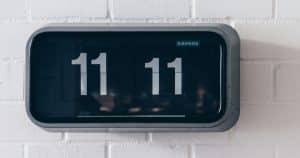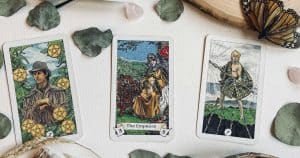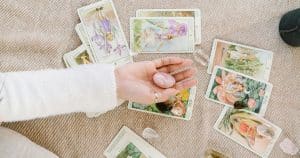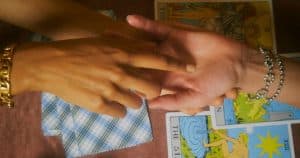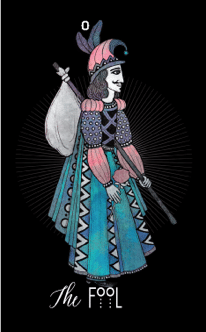
My first recommendation when learning to read the tarot is to choose a deck with which you are comfortable and feel aligned. The next step is to actually spend time getting to know the cards, and to familiarize yourself with their imagery and the messages each card imparts. That’s because individual cards are more than just pictures that mirror a singular, fixed meaning.
Each card has not only its own story to tell—a story full of nuances and mutable interpretations that fluctuate, depending on the influences of other cards that surround it in a spread—every card also has a part in the larger story that is an entire reading. So each card in its particular place becomes one chapter in a novel, one square in a quilt, one scene in a film.
A Living Vision
When I was first learning to decipher the tarot, the cards were very vivid to me. I used to pull out my deck—a traditional Rider-Waite that was gifted to me by a relative—randomly shuffle, and pull out a card on which to concentrate. Back then, the cards actually seemed to come to life.
By focusing my attention without distraction, I often felt as if I was having a Through the Looking-Glass experience. Another world—the world inside the card—seemed to come to life (although unlike Alice, I was watching a scene in a movie rather than participating in one). By concentrating on the cards in this manner, I was able to appreciate small details and subtle symbolism that I might otherwise have missed.
Growing Up vs. Growing Closed
I think it might have been easier to accomplish this suspension of disbelief because I was still fairly young at the time I began reading tarot, about 14, and I had yet to construct many of the roadblocks and constraints adults place on “reality” as we mature and become the people we think we’re supposed to be. Unfortunately for many people, growing up is often a euphemism for closing doors to alternative channels of perception.
To me, one of the saddest things about being an adult is how much wonder and magic and truth we miss on a daily basis because we refuse to acknowledge the possibility of forces that cannot be measured or put in a specific box. Being open to tarot is akin to wholly giving yourself to any faith-based system. It involves trust. It involves belief, and it involves the willingness to disbelieve many of the things we’ve taught ourselves are the finite limitations of human existence. If you want to be truly in tune with the tarot, you must be willing to let many of those constraints go.
Getting Clear
Of course, that’s easier said than done, but if you’re serious about getting to know and understand the cards, and opening yourself to the messages they can share with you, make a commitment to put in the time and effort any new relationship takes.
Choose a place that’s quiet and has a pleasant ambiance. Soothing lighting and calming music or nature sounds (no doubt there’s an app for that!) can enhance the experience, but aren’t mandatory. Do plan a time for these sessions that you won’t likely be interrupted, and if possible turn off the call and text alert functions on your phone. Consider what you’re doing as a meditation. Any outside influences that come between you and your cards will disrupt the flow of communication.
Now, simply begin laying out the cards and try to concentrate on what they’re telling you. Is it better to do this one card at a time, or to lay out several cards and try to interpret a pattern? It doesn’t really matter. Proceed in whatever manner you feel most comfortable. Let the process develop organically, and see where it leads you.
Okay, so what happens if you don’t get any messages, or worse, if you just feel plain silly? Don’t worry. It can take time to dismantle the walls you’ve put up, and unblock the channels of communication. It takes patience, practice, and commitment, but if you really want to hear what the cards have to say to you, eventually, their messages will come through loud and clear.
Of course, intuitive reading is not for everyone. If you prefer a pragmatic approach, there are any number of books and online sites that detail precise meanings for each tarot card, and also explain what impact the cards have in relationship to where they appear in a given spread. A simple search at an online book retailer can turn up a wide variety of resources to help you find the method with which you feel most comfortable.
After you’ve spent some one-on-one time with the cards, why not reach out and consult with a KEEN advisor to unlock the full picture?



